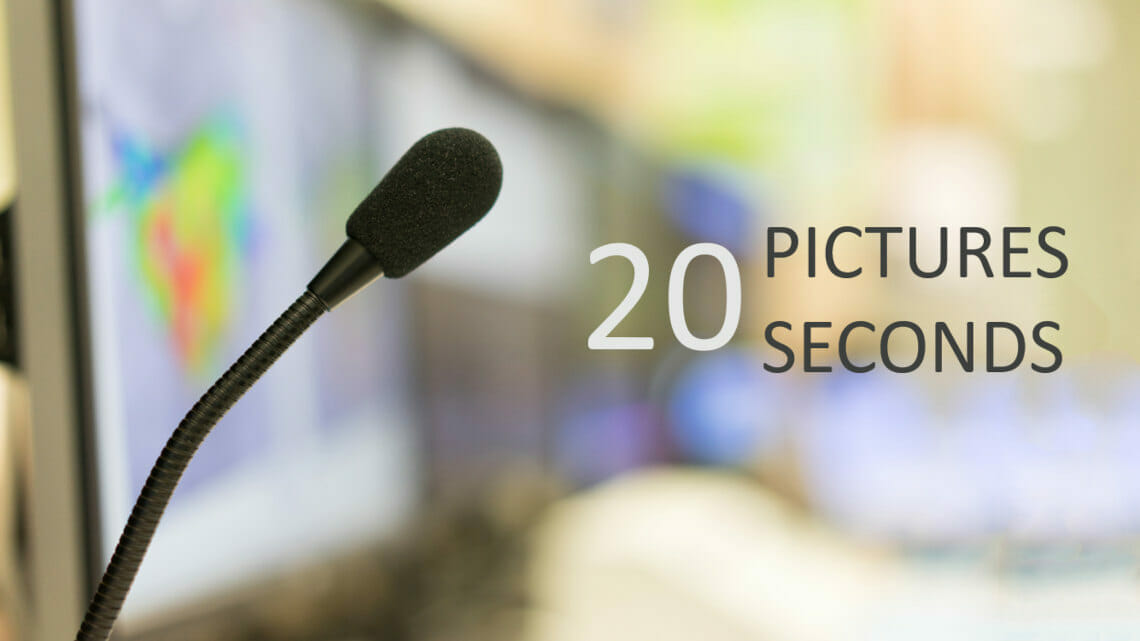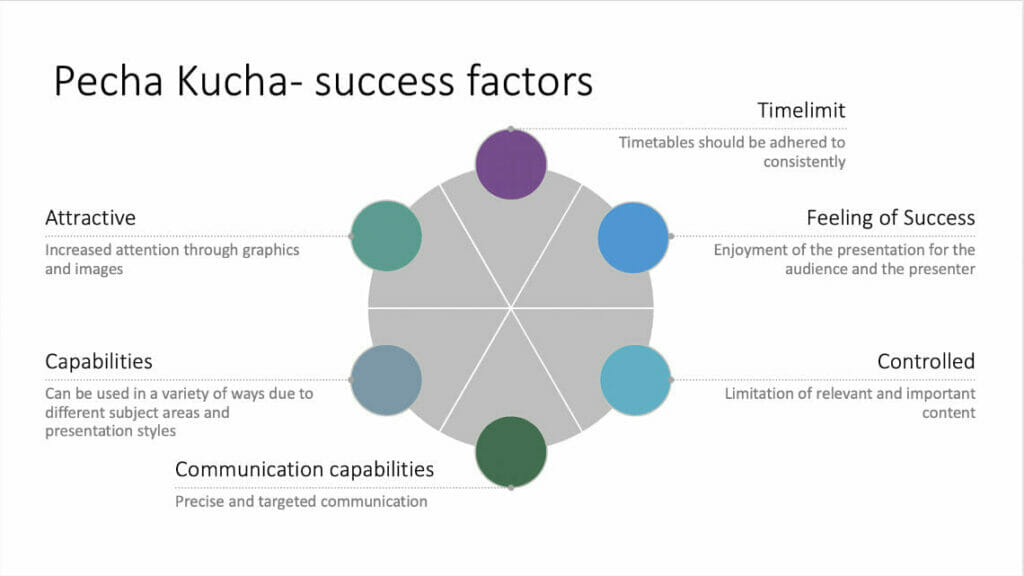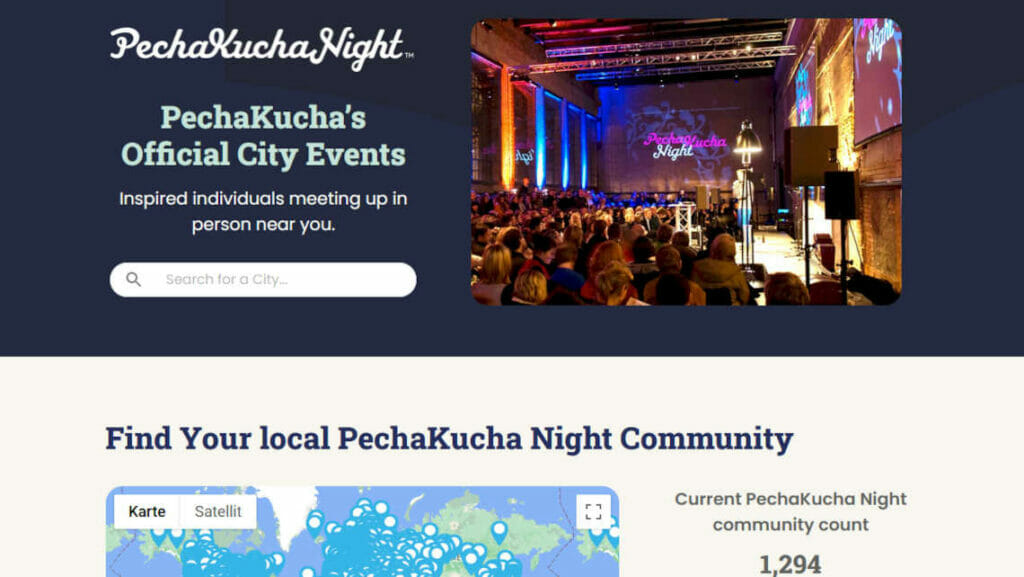
PechaKucha: PowerPoint Presentations with a Difference
For those of us interested in presentation techniques, PechaKucha is a two-word term that we hear often. Although it may sound like some exotic dish you order off a menu, PechaKucha is in fact an incredibly unique form of presenting.
A PechaKucha presentation is designed to save your audience from the dreaded “death by PowerPoint”. Keep reading to find out what PechaKucha is all about and how you can use it to your advantage.
What is PechaKucha?
PechaKucha is a Japanese word that translates to something like “confused chatter” or “babble of voices”.
PechaKucha was brought to life in 2003 by Astrid Klein and Mark Dytham of Klein Dytham Architecture in Tokyo. This presentation technique was invented by architects, but it works wonderfully for short presentations in other industries, such as tourism, wellness or in marketing and management.
The reason behind PechaKucha presentations

PechaKucha is an innovative method that makes slideshows, or PowerPoint presentations, more effective. Presentations are often drawn out and dull, and the average person’s attention span is short. This means that during a long presentation, only small fragments of the key content are being absorbed.
PowerPoint experts often speak of “death by PowerPoint”. Metaphorically speaking, this is when many audience members switch off before they’ve even heard the core of the presentation. The solution for this is: the PechaKucha presentation.
The PechaKucha presentation is a unique, short presentation with a fixed duration. The presentation contains 20 slides, each of which is shown for 20 seconds. The entire presentation has a length of exactly 6 minutes and 40 seconds.
Presenters have no control over this and must strictly adhere to the time frame. This ensures that an audience is able to take in all key information. The presentation’s script has to be aligned exactly with the slides shown. You can find tips on how to do this further down in the article.
Another distinctive feature of the PechaKucha presentation is that the 20 slides are not text slides, but picture slides. Your audience sees only one image with no or little text while you have a time window of 20 seconds to explain it. The PechaKucha presentation focuses on meaningful images and graphics. The goal of this method is to convey content concisely, avoid “death by PowerPoint” and increase an audience’s attention.
The PechaKucha presentation has many advantages:
- A fixed time frame: Presenters have no opportunity to drag out and prolong their presentations unnecessarily.
- Boiled-down information: Presentation content is to the point and easier to understand.
- An entertaining presentation: PechaKucha’s brevity is a breath of fresh air for an audience. “Death by PowerPoint” is completely avoided.
- Variety: With its unique structure, a PechaKucha presentation is anything but commonplace; it has a unique appeal and becoming increasingly popular.
PechaKucha doesn’t work for every presentation topic
Think carefully about whether a PechaKucha presentation is the right type of presentation for your topic. For example, PechaKucha doesn’t lend itself well to presentations on financial reports or related topics. Due to PechaKucha’s time constraints, valuable information on graphs or charts can easily get lost, leaving the audience with a lot of questions.
This type of presentation is also not recommended for topics that require discussion. There is simply no time to include questions or discussion points in the allotted time frame.
How to prepare for a PechaKucha presentation

Preparation is key for a PechaKucha presentation. The visuals need to be carefully selected and suit your presentation to a tee. Other things to consider are:
- How should you structure your presentation?
- What storytelling elements can you bring to the table?
- What do you want to convey? What is your core message?
- How can your images reinforce your core message?
- Where can you find suitable images?
Our tips:
Tip #1: Divide your presentation into a beginning, middle and end.
You have two options. If your topic is complex and you don’t want to waste time, you can go straight to your main point. Or you can build an arc of suspense by starting your presentation with a short anecdote, and then lead your audience to the actual topic. This allows you to establish surprising references and create little aha moments.
Other possibilities for a suspense-building opening are:
- A quote
- A question (with or without a vote)
- A short story
For the conclusion, grab your audience’s full attention with a call to action. More information about this can be found here.
Tip #2: Storytelling and PechaKucha go hand in hand.
Nothing creates a dramatic build-up and arc of suspense better than storytelling. This is how you evoke emotions in the audience. Draw from life; tell about moving, involving moments. For more tips, check out our storytelling article.
Tip #3: Focus on the core message.
Define your key message as precisely as possible and weave your presentation around it. Get as familiar with your topic as you can. You’ll quickly find a convincing presentation structure that fills the 7 minutes informatively and gets to the heart of the matter.
Further tips on this can be found in our blog post.
Tip #4: Find images that follow your storyline.
You want to develop a story that your audience can invest themselves in. People love visual stimuli. Your images, photos or even graphics should be crisp and in a high enough resolution. Remember that pictures play a key role in a PechaKucha presentation.
Choose pictures that will pique your audience’s interest. Pictures with an object in the middle often work well. In contrast, statistics or images with too much detail don’t translate well in a PechaKucha time frame.
Of course, the images should correspond to your topic. Randomly selected images without a deep connection to the presentation quickly look unprofessional and out of place.
Tip #5: Pictures can be found everywhere.
Take your own photos with your camera or smartphone, scan photos from newspapers, magazines or books, buy images from providers like Fotolia, use graphics programs, or create your own collages and drawings. There are so many possibilities! If you’re using something other than your own image, don’t forget to acknowledge the source on each slide.
Tip #6: Practice your presentation.
Giving a PechaKucha presentation takes practice. The strict time frame requires you to deliver your presentation fluidly. Stumbles or other mishaps could waste valuable time. Practice A LOT in advance. Also, pay attention to your body language while you present. Try to stay relaxed and speak with intention.
PechaKucha Nights (PKN)

The PechaKucha presentation has become so popular that there are gatherings all over the world called PechaKucha Nights. The PKNs take place mainly in large cities, such as Cologne or Berlin. You can find more information about these evenings and what’s happening near you on the official PechaKucha website.
Try a PechaKucha PowerPoint presentation – a unique way of presenting
Compared to standard PowerPoint presentations, PechaKuchas come from a different angle and is not without its challenges. Its picture slideshow makes choosing the right images even more important than with an ordinary presentation.
On top of that, you’re limited by the time frame. But PechaKucha offers one huge advantage: you won’t lose your audience’s attention and you’ll save them from the dreaded “death by PowerPoint”.
Think about whether your topic fits this type of presentation and its time frame. Prepare well for the presentation and take our tips to heart.
Do you have any questions about PechaKucha presentations or PowerPoint in general? Feel free to contact us by sending an email to [email protected]. We’re here to help!
Are you looking for professionally designed slide templates to form the cornerstone of your presentation? Feel free to take a look around our shop. You’ll find a wide variety of slides on numerous topics. You’re sure to find something for your presentation! ► To the shop
These posts might also interest you:




